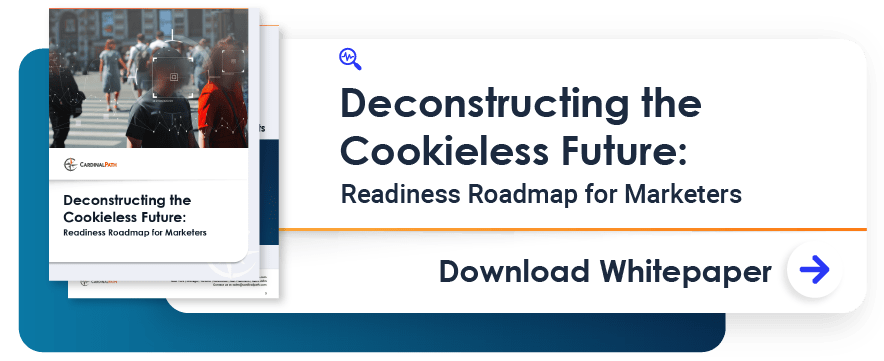As consumers become more aware and concerned about how their data is being used, governments and businesses are taking steps to protect the data privacy of their citizens and customers. As a result, third-party cookies are on the way out. For marketers in all industries, there is a rising awareness on how much reliance there has been on marketing platforms to natively identify and interconnect users. Now, more than ever before, marketers must learn to build their own strategy around identity, on top of their existing marketing strategies.
For a deep dive on how marketers can adapt, check out Cardinal Path’s “Deconstructing the Cookieless Future” whitepaper. You’ll see that having a solid first-party data strategy and stitching together data sets through clean rooms and people-based marketing platforms will play a big role in success.
In this blog, we’ll look at how this future will specifically impact marketing analytics. We’ll discuss some implications of cookie loss to your organization. Then we’ll explore how building a centralized and nimble data capability will enable companies to improve marketing attribution, customer experiences, and adaptability to act on future opportunities.
The data challenges: The impacts of a cookieless future
From a marketing analytics perspective, the cookieless future will impact businesses in ways that won’t be immediately apparent, to a marketer approaching this problem for the first time. Many marketers rely on cookies-without realizing it-to answer questions about their customers such as tracking new leads per month or analyzing sales from new customers. These metrics are provided directly from their marketing platforms without the marketer needing to know the mechanics behind each metric’s calculation.
Soon, companies will have a harder time answering these questions because browser-based data will become a less effective means of recording and maintaining customer records. This means that the core identifier that determines whether a lead is new for that user, or whether that customer has ever engaged with your ads before, will change.
The cookieless future will impact some industries more than others. On the one hand, B2B companies will likely be less impacted because they inherently collect more first-party data at more stages of the funnel. For example, collecting emails as part of an event signup. Compare to the automotive industry, which has less opportunities to collect first-party data. It might not be clear who a customer is until they physically arrive in a dealership location. These types of industries will have a more difficult time connecting online browser behavior with offline customer sales activity, but the challenge will be fairly universal across all industries for early funnel engagements.
Even if an organization’s digital metrics primarily rely on first-party cookie data from analytics platforms, most user data from these sources will be anonymous and disconnected from identified user spaces (such as CRMs, CDPs, and more). Without proper planning and strategy, your ability to connect this anonymous cookie data back to your known data sources will be limited. This means that it is very important that organizations make a plan to control and integrate their data sources with identity at the forefront of their decision making.
The data warehouse solution: A centralized and nimble data approach
In a cookieless future, every company will need to plan ahead to gather and act on the customer data they need to enable great business decisions and customer experiences.
Building out a centralized data warehouse
The first and most important thing that a company should do is adopt a centralized data warehouse. Then they should start working to get their key data sources into that repository, including CRM data, marketing data, and product data. This enables long-term access and ownership over data, which makes it easier to understand your own data gaps and work towards stitching data together. From there, companies can begin to create audiences for their marketing efforts. This effort also builds a central source of truth on their organization’s business performance.
Depending on an organization’s existing data maturity, the path to developing this capability will take different forms:
Still platform reliant: Some companies may have very advanced marketing strategies, but are heavily reliant on marketing platforms to manage their data. They haven’t invested very much in their own data warehousing capabilities, and are instead letting their marketing platforms act as their data warehouse. Going forward, they’ll need to start taking ownership over and centralizing their data to create more data visibility and control. This means establishing new cloud-based data warehousing platforms. Google Cloud Platform offers the best integration with Google Marketing Platform, if this is where your primary media investment is based.
A little ahead of the game: Some companies are quite mature in their capabilities and have developed their data warehouse. Their first step should be reviewing their data and finding identifiers—such as user IDs, form IDs, interaction IDs, and transaction IDs—to fold into their data to enhance their ability to connect data, tell richer stories, and better understand the customer journey.
On the leading edge: Companies that are already doing this work should think about folding valuable data from identity platforms into their own data sets. A solution like LiveRamp, Merkle Merkury, and/or Demandbase might come into play to enhance existing data—enabling companies to tap directly into these vendors’ identity solutions and smart algorithms to find and match user data together with the company’s existing data. Companies at this maturity level should also evaluate the potential value of adopting a cleanroom solution like Google Ads Data Hub.
Being nimble in gathering and using data
It’s very common for companies to become reliant on methods for working with data that “work” even if they aren’t the most efficient or future-proof. It’s also common for companies to not think about their digital data as something that they own, but simply something that enables the actions that they want to take on a day-to-day basis, such as setting internal revenue targets or setting audiences for media targeting. Alternatively, when companies take ownership over their data, they can start to manipulate, analyze, integrate and use it in creative ways to bring more value to the business.
To avoid getting “tech locked,” companies should think about how their organization is structured and if they are currently able to manage their own data. If not, they should seriously consider building a data management team (and yes, this may mean onboarding some pricey data engineers and analysts) to empower the company to own and take action with their own data. Having those resources internally provides flexibility as marketing strategies and platforms change, making it possible to support marketing capabilities, integrate new data sources and act on new opportunities.
Unified data unlocks results: Better business decisions and customer experiences
With a full view of their data in a centralized data hub, companies will be able to make better operational decisions and enable better customer experiences.
Activating better attribution for businesses
By taking steps to centralize, enhance and own their data, companies can perform effective attribution analysis to really understand what is driving and contributing to sales. Many brands rely on platforms to do their attribution analysis for them. These platforms, such as the Google Marketing Platform, work well. However, especially in light of the cookieless future, companies that develop their own capabilities will be able to get answers to attribution questions that are more relevant to their unique business needs.
With more direct ownership over their data, companies can answer more specific questions. For example, they can understand not only how various marketing efforts impact each other along the path to conversion, but also the impact of other efforts like offline touchpoints and phone call data.
As cookies play a reduced role in understanding customers, companies will see less value out of in-product attribution reports from marketing platforms. And for companies that are already doing their own attribution reporting, it’s important to think about the additional joins that can be done with their data or what data they will need in the future to enhance their data sets. This will be especially important if these companies are relying on cookie-based customer identifiers provided by these marketing platforms.
Enhancing experiences for customers
Customers are already seeing more and more ads that are less relevant to them. By gathering data on behaviors and preferences across channels, companies can deliver more relevant experiences for customers. As companies pivot to gathering more first-party and zero-party data to achieve this, they may be tempted to adjust digital user experiences to convince customers to share this data. Though, these companies should tread carefully.
Since cookies are going away, customers will see more attempts from brands to capture their data. People are now much more aware and concerned about their data privacy, so companies need to protect their brand. Ideally, they should gather information without impacting the user experience. On the other hand, a model that has worked for news publishers for years is offering some content for free and requiring a subscription to access premium content. The idea is to gather user data when the company has a very good reason to do so—in ways that are least impactful to the customer experience.
Taking the right next step toward a cookieless future
Change is just around the corner, but there’s still time for companies to build out their analytics capabilities. It starts with an internal conversation about the company’s current maturity, their vision for the future, and the practical next steps to make it happen. With some smart investment and planning upfront, companies can deliver for their customers and stakeholders in a cookieless future.

Author
Tara is Director of Data Engineering on Cardinal Path's Data Science team. She focuses on advancing clients' capabilities by solving their challenges in data integration and transformation. With a deep background in consulting across a variety of verticals and platforms, Tara is often a heavily relied upon resource to bridge communication gaps and unlock technical barriers.
View all posts













